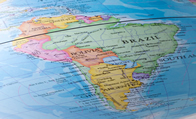 Companies seeking to lessen the risk of payment defaults among corporate customers and suppliers in Latin America are in general should focus on those in countries with Pacific coastlines, and in any case be especially wary of those engaged in the textile-clothing, metals, construction and chemicals sectors.
Companies seeking to lessen the risk of payment defaults among corporate customers and suppliers in Latin America are in general should focus on those in countries with Pacific coastlines, and in any case be especially wary of those engaged in the textile-clothing, metals, construction and chemicals sectors.
Those are general findings by Compagnie Française d’Assurance pour le Commerce Extérieur (Coface) in the January issue of its Panorama report. The provider of corporate-default-risk insurance noted that the region achieved overall GDP growth of 4.2 percent between 2003 and 2013, but last year “surprised on the downside” in most countries.
“The region´s GDP is expected to grow by 1.3 percent in 2014 and by 2 percent in 2015, much lower than the previous years,” the report says.
The drop stems in large part from less Chinese demand for metals, soy and other commodities that have driven growth in Latin America economies, and that ebb in demand is unlikely to turnaround in the medium term. Coface anticipates the China to report growth of 7.4 percent in 2014, falling to 7.0 percent this year.
“The Pacific countries are growing at a higher rate, but generally all countries (in Latin America) are growing at a slower rate than the previous decade, and that’s mainly due to the slowdown in China,” said Patricia Krause, a Coface economist focusing on Latin America and author of the report.
Other factors leading to Latin America’s anemic growth, according to Coface, include less economic activity worldwide as well as insufficient investment by those countries in infrastructure.
Chile’s A2 rating by Coface, based on the average risk of payment defaults by companies in the country, was the highest among the eight Latin American countries with the largest economies, and it has held that rating since at least 2004. Brazil, Colombia, Mexico and Peru were tied at A4, with Brazil dropping from A3 in 2013 while the others held steady. Ecuador followed with a B rating, and then Argentina at C, while Venezuela was the riskiest with rating of D, the lowest possible.
Chile was the best positioned in terms of infrastructure development, but nevertheless was ranked at 49th among 144 countries by Coface.
“The whole region has bad infrastructure, so it can only improve,” Krause said.
In terms of payment default risk by industry, only pharmaceutical companies’ risk was determined to be moderate by Coface, which ranked that risk for the agro-food, retail and automotive sectors as medium, and the textile-clothing, metals, construction and chemicals sectors as high risk.
The payment performance of those companies is likely to vary by country. The health of Mexican manufacturing, for example, is tied closely to the U.S. economy, which strengthened significantly. Coface notes it has emphasized free markets and trade alongside Chile, Columbia and Peru, enabling them to focus more on goods in which they hold comparative advantages and to increase productivity gains. Those on the Atlantic coast, especially Venezuela and Argentina, face inflation and slower growth.
Coface anticipates Brazil also remaining weak in 2015, due to its lack of infrastructure investments and the government having to raise artificially suppressed prices, such as for energy.